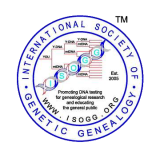Forensic genealogy
From ISOGG Wiki
Forensic genealogy is a term used particularly in the US to describe genealogical research, analysis and reporting in cases with legal implications, often involving living individuals.[1]:337 Forensic genealogists may be called upon to appear in court to provide expert testimony, and typically furnish affidavits and research reports to their clients that adhere to the Genealogical Proof Standard established by the Board for Certification of Genealogists.[2]
Definition
Forensic genealogy is defined in a legal context, specifically when conducting research in the following manner:
- Estate or probate research to identify unknown and missing heirs, and potentially provide expert testimony in a courtroom;
- Military repatriation: Assisting branches of the United States military in reuniting the remains of service members with their families using DNA analysis (a.k.a. DNA profiling);
- Kinship determination: Identifying family members in regard to cases of adoption, foster care, and guardianship;
- Land and real estate issues involving title, adverse possession, rights of way, lis pendens, or muniment of title, and oil, gas, and mineral rights and royalties. Oil, gas, and mineral rights cases may be dealt with the same as unknown and missing heir cases, or quiet title actions, depending on the state with jurisdiction and the situation of the case;[4]:454
- Established law in Texas gives landowners the rights to oil and gas beneath their property.[5]
- Research to help clients establish U.S. citizenship or support dual citizenship in a foreign country;
- Assisting coroner’s offices in identifying relatives of unclaimed remains;
- Provenance, class action claimants, intellectual property rights, etc.
An alternative definition of the field has been explained by Colleen M. Fitzpatrick in her 2005 self-published book Forensic Genealogy,[6][7] in which a forensic science approach is used in genealogical research. The author describes various research methods, approaches, and genealogical knowledge she has determined to be forensic in nature:
- Examining photographs for clues to pinpoint a place or time of an event. For example, a house in the background of a photo may reveal an address number, or the type of clothing worn by people can suggest when a picture was taken.
- Estimating birth dates by scrutinizing marriage age laws of a jurisdiction;
- Researching “the historical context of your family" to provide more insight into their lives;
- Understanding that immigrant name changes did not occur at Ellis Island, but either at the immigrant’s embarkation point or years after entry to the United States;
- Analyzing DNA test results to study both matches and non-matches, as well as estimating one’s most recent common ancestor (MRCA), and discovering non-paternity events;
- Using a Y-chromosome cladogram “to identify the main branches of a family”; etc.
History
Professional forensic genealogists have been in practice since at least the 1950s. Paul Noot was an early practitioner who founded a forensic genealogy business in 1959 to match "unclaimed inheritances with unknown and hard-to-find heirs.[8] Noot was said to have been "inspired by a TV program and a magazine article about forensic genealogy, the tracking of missing heirs."[8]
Herb Saxton was another early practitioner. He listed forensic genealogy on his calling card in 1966.[9]
In the early years it was a very niche field with a small number of practitioners. By 1984 it was reported that there were "only six or so major firms in the country [the US], each with seven or eight investigators and another handful of agents based in various regions. In addition, a small number of hunters work for themselves."[10] Forensic genealogy was the preferred name for the leading practitioners at that time:
“They don’t like the name “heir chaser,” but they accept “heir hunter” or “probate researcher” and they proudly answer to “forensic genealogist”… Whatever the name, they search for missing heirs who have no idea they are either heirs or missing.”[10]
Education
The Salt Institute of Genealogy and the Genealogical Research Institute of Pittsburgh offer courses in forensic genealogy.
The US National Institute for Genealogical Studies offers a correspondence course in forensic genealogy.
External websites
- Council for the Advancement of Forensic Genealogy
- Association of Professional Genealogists. This organisation maintains a directory of professional genealogists, many of whom list forensic genealogy as a specialty. They also have a forensic genealogy special interest group
- Board for Certification of Genealogists
References
- ↑ "Ramage, Michael S. (2018). "Chapter 15: Forensic Specialization". in Shown Mills, Elizabeth. Professional Genealogy, Preparation, Practice & Standards. Genealogical Publishing Co.. p. 337. ISBN 9780806320724.
- ↑ Ramage MS. Standards and Forensic Genealogy. OnBoard 2016; 22: 17–18, 23.
- ↑ 3.0 3.1 Ramage, Michael S. (2005). "Missing and Unknown Heir Law Practice and Procedure". Pennsylvania Bar Association Quarterly 76 (July): 125.
- ↑ American Bar Association, Committee on Administration and Distribution of Decedent’s Estates (1975). "Clearing Title of Heirs to Intestate Real Property". Real Property, Probate and Trust Journal 10 (Fall): 454.
- ↑ "Oil & Gas Exploration and Surface Ownership". http://www.rrc.state.tx.us/media/7124/surfaceownerinfo.pdf.
- ↑ Fitzpatrick C and Yeiser A. Forensic Genealogy, Rice Book Press, 2005.
- ↑ Bopp GK and Bopp TT. Book review: Forensic Genealogy. Journal of Genetic Genealogy Spring 2006, Volume 2, Number 1.
- ↑ 8.0 8.1 Star Tribune [Minneapolis, Minnesota], 19 May 2005.
- ↑ Oxnard Press Courier [California], 6 March 1966.
- ↑ 10.0 10.1 Oliver M. Forensic genealogy can be awfully heir-raising. ‘’Sunday News Journal’’, Wilmington, Delaware, 1 July 1984.
Bibliography
- Board for Certification of Genealogists. Genealogy Standards (second edition revised). Ancestry.com/Turner Publishing, 2021.
- Mills, Elizabeth Shown (ed). Professional Genealogy: Preparation, Practice and Standards. Genealogical Publishing Company, 2018.
| This article is licensed under the GNU Free Documentation Licence. It uses material from the Wikipedia article "Forensic genealogy". |
